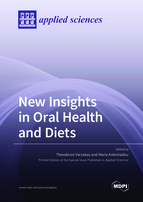New Insights in Oral Health and Diets
A special issue of Applied Sciences (ISSN 2076-3417). This special issue belongs to the section "Food Science and Technology".
Deadline for manuscript submissions: closed (30 September 2021) | Viewed by 38020
Special Issue Editors
Interests: food technology; food engineering; food safety; food quality; extra virgin olive oil; mycotoxins; fermented foods
Special Issues, Collections and Topics in MDPI journals
Interests: dental biomaterials; restorative dentistry; professional aspects of dentistry (dentistry in unprivileged groups, holistic treatments in caries prevention and diet, dental management, marketing, and dental coaching)
Special Issues, Collections and Topics in MDPI journals
Special Issue Information
Dear Colleagues,
The aim of this Special Issue is to bring the most updated information on the innovative field of oral and general health coaching and nutritional education strategies for better oral and general health. The world of adult education needs information on instruments that provide behavioral changes and support physical emotional and spiritual health of modern individuals. Under this scope, the Special Issue will incorporate articles of modern diet perspectives and coaching approaches that lead to new dietary habits. Suggestions for the food industry that will help toward better food choices for the geriatric and adult population will also be outlined. The link between industry, the medical and dental practitioner, and the consumer–patient will be explored in a more productive collaboration from every aspect.
Highlights:
- Oral health coaching and communication strategies on diet;
- Nutritional aspects of modern societies for the geriatric and adult population;
- Malnutrition and oral health status;
- Industry approaches to modern packaging and dosage of food related to population needs.
The aim of this Special Issue is to attract papers in the general area of food industry and geriatric and adult dietary intake philosophy as well as counseling and coaching processing techniques and values for healthier diets.
Prof. Dr. Theodoros Varzakas
Dr. Antoniadou Maria
Guest Editors
Manuscript Submission Information
Manuscripts should be submitted online at www.mdpi.com by registering and logging in to this website. Once you are registered, click here to go to the submission form. Manuscripts can be submitted until the deadline. All submissions that pass pre-check are peer-reviewed. Accepted papers will be published continuously in the journal (as soon as accepted) and will be listed together on the special issue website. Research articles, review articles as well as short communications are invited. For planned papers, a title and short abstract (about 100 words) can be sent to the Editorial Office for announcement on this website.
Submitted manuscripts should not have been published previously, nor be under consideration for publication elsewhere (except conference proceedings papers). All manuscripts are thoroughly refereed through a single-blind peer-review process. A guide for authors and other relevant information for submission of manuscripts is available on the Instructions for Authors page. Applied Sciences is an international peer-reviewed open access semimonthly journal published by MDPI.
Please visit the Instructions for Authors page before submitting a manuscript. The Article Processing Charge (APC) for publication in this open access journal is 2400 CHF (Swiss Francs). Submitted papers should be well formatted and use good English. Authors may use MDPI's English editing service prior to publication or during author revisions.
Keywords
- oral health coaching
- Malnutrition
- innovative food products
- processing
- geriatric population
- nutritional aspects







